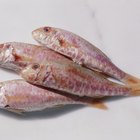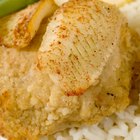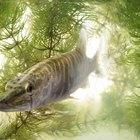
There are two distinctly different types of fish known as jackfish. Both are voracious predators, valued primarily by anglers for their excellence as a sport fish. Most species known as "jackfish" belong to the family of saltwater fish called Carangidae. These include crevalle jacks, amberjacks and bar jacks, caught in waters along the Eastern Seaboard and down to the Caribbean. Colloquially, inland anglers often apply the term "jackfish" to pike and pickerel, bony, torpedo-shaped predators that inhabit many Midwestern waterways. Saltwater jackfish have dense flesh that lends itself to grilling, while pike are better fried or baked.
Saltwater Jacks
Step 1
Check your fillets for pin bones, a line of short, barely visible bones that runs down the approximate center of the fillet. They're hard to see, and more easily found with your fingertips.
Step 2
Pull out the bones individually with tweezers, or use the tip of a sharp knife to make a narrow V-shaped cut that removes the entire line of bones along with a small amount of the flesh.
Step 3
Brush or spray the fillets lightly with oil, and season them with salt, pepper or other spices as desired.
Step 4
Place the fillets on a preheated grill and cook them over moderately high heat for approximately 10 to 12 minutes, turning once. When the meat in the thickest part of the fillet turns from opaque to white, the fillet is done.
Step 5
Serve the fillets immediately, with your choice of sauce and side dishes.
Pike
Step 1
Lay your fillets on a cutting board, and slice away the rib cage by sliding your boning knife beneath the ribs and cutting towards the edge of the fillet. The ribs should lift away in a single piece, held together by a thin membrane. Keep your knife blade pressed to the bones, to minimize wastage.
Step 2
Feel for bones at approximately the mid-point of the fillet. There will be a line of them, running well down the length of the fillet. They're difficult to remove with tweezers, so the best option is to simply cut out that section of the fillet. This leaves you with two oblong strips of flesh joined to the tail.
Step 3
Separate the tail portion of the fillet from the remainder, and set it aside. Cut the long strips of fillet into two or more portions each, depending on the size of your pike.
Step 4
Season the fillets and dredge them in flour or fine cornmeal, and pan-fry them in a small amount of oil. Alternatively, dip the portions in milk or a beaten egg and then breadcrumbs. Spray them with oil, and oven-bake them until the crumbs turn golden. Pike can also be baked in white sauce or tomato sauce, which helps the fillets remain moist in the oven's heat.
Related Articles

How to Clean Mullet

How to Cook Pickerel in the Oven

How to Cook a Fresh Perch

How to Cook Fresh Brook Trout

How to Cook Swai White Fish on the Grill

How to Pan Fry Tasty Perch Fillets

How to Cook Stuffed Tilapia
How to Cook Seasoned Keta Salmon

How to Cook a Breaded Thick Cube Steak

How to Cook Sauteed Perch Fillets

How to Cook Salmon on a Griddle

How to Fillet a Goliath Grouper

Easy Way to Debone a Trout
How to Cook a Turbot in the Oven
How to Cook Bone-in Tilapia

How to Clean Scallops
The Best Way to Cook Tilefish

How to Cook Filet of Branzino

How to Cook a Pickerel Fillet

How to Cook Haddock on the Grill
References
Tips
- Saltwater jacks are not as flavorful as pompano -- a close relative -- but are tasty when grilled. Amberjacks are the best for eating, though ordinary bar jacks and crevalle jacks are also very acceptable. Their texture is dense and meaty, rather like tuna, and pairs well with fruit salsas or other acidic ingredients such as grilled tomatoes. Fillets are sturdy enough to cook directly on your grill without a protective basket, as long as your grill's grate is seasoned well enough to minimize sticking.
Writer Bio
Fred Decker is a trained chef and prolific freelance writer. In previous careers, he sold insurance and mutual funds, and was a longtime retailer. He was educated at Memorial University of Newfoundland and the Northern Alberta Institute of Technology. His articles have appeared on numerous home and garden sites including GoneOutdoors, TheNest and eHow.
Photo Credits
Jupiterimages/Photos.com/Getty Images